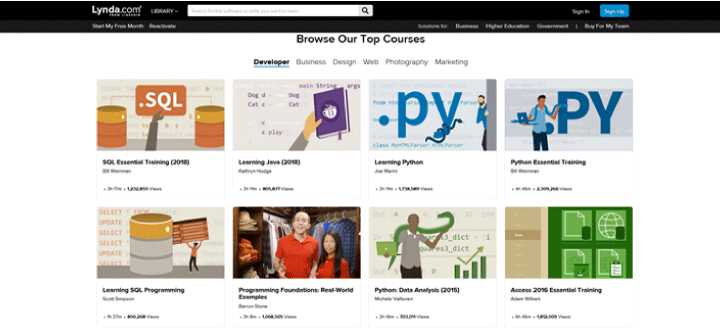
Businesses incur significant costs from employee turnover: From 50% of an employee’s salary for an entry level position to 200% of a senior executive’s salary.¹
Right now, though, turnover is the last thing on employees’ minds. That said, employees still want opportunities for advancement within their company.
Next to low pay, a lack of opportunity for advancement is the second most common reason that employees leave their jobs.
How to Create Opportunities for Employee Advancement
Now that few employees want to willingly leave their jobs, small businesses can create opportunities for advancement, shore up skills gaps, and retain talent in the future by:
- Prioritizing skills
- Leveraging digital opportunities
- Building mentorship networks
Prioritize Skills Building
Businesses that provide upskilling opportunities meet employee expectations to promote their engagement.
Though often conflated, it is important that businesses differentiate between a need for upskilling and retraining.
Whereas upskilling refers to an advancement in skills to help an individual become more valuable in their current role, retraining involves developing significant different skills to help an employee fit a new role.
Ask employees to self-report skills for evaluation. From there, leadership can identify candidates for upskilling and those for reskilling. In conjunction with business needs, employers can make an informed decision about which program to execute.
Whether upskilling or reskilling, the development opportunity should include a variety of skills.
The majority of employees expect development opportunities in a variety of areas.

Employees want to develop an array of skills. This challenges small businesses to create a program that satisfies both budgets and employees.
To accommodate the expansive interests cost-effectively, businesses can experiment with the following options:
- Cross-functional jobs: Employees work across teams to develop knowledge of different disciplines.
- Rotational programs: Rotate employees through a variety of positions throughout their time at a company.
Businesses can leverage existing resources within an organization such as different teams to upskill employees cost-effectively.
A variety of professional development opportunities meet employee’s expectations to keep them engaged and reduce turnover.
Leverage Digital Learning Platforms and Opportunities
Small businesses can take advantage of massive open online courses (MOOCs) to advance employees outside a classroom setting.

Businesses can create their own eLearning courses or purchase existing ones from sources such as edX, Udemy, or Lynda.com (LinkedIn Learning).
Employees can select from thousands of courses that range in subject matter from 3D animation to cloud computing. They can also adjust the difficulty of the content to fit their levels of expertise.
Courses are provided through an eLearning system, which enables unlimited participation by employees at minimal cost.
For example, through the LinkedIn Learning partnership, a subscription only costs around $30 per month. Lynda.com subscription plans range including monthly, premium monthly, and annual subscriptions.
Small business owners also have a high degree of control through administration capabilities. Leaders can develop custom learning paths for employees by linking a series of MOOCs on specific topics.
Company sponsored upskilling is particularly popular amongst employees. According to Clutch, 43% of employees consider participation in such programs as the primary means to gain the skills and knowledge to be successful in their role.
Businesses can also leave MOOCs open, which provides employees with a high degree of flexibility. Employees leave and return to courses based on their work schedules which will encourage participation, as Clutch found that 70% of employees most enjoy development programs during the day.
Digital platforms offer small businesses affordable options to engage employees in upskilling on their own time.
Build a Mentorship Program Within Your Company
A mentorship program is an inexpensive and effective method to promote employee development.
In-person workshops are the preferred learning method by employees.
Companies can assign mentors based on professional experience and aspirations to institute the most effective support system for each employee.
Businesses can also match mentors and mentees based on gender. Women in positions of leadership inspire younger female employees, which helps them to succeed in the workplace.
Two-thirds of Americans find it particularly important for women to have role models when starting their careers. A role model is especially important to millennial women: 82% stated it is highly important that younger women have more women in leadership positions as role models.
A greater number of women in the workplace benefits businesses bottom lines. More gender diversity in an organization attracts top talent and leads to an increase in market value.
By easing their transition and providing an established support system, companies benefit from lower turnover. Mentor programs decrease employee turnover as a result of higher job satisfaction and commitment to the organization.
Mentorship provides leadership opportunities for mentors and a uniform, cost-effective training program to satisfy employees’ preferences.
Provide a Variety of Resources to Meet Employees’ Expectations
Small businesses that offer employees a variety of resources to advance their skill sets and careers will benefit from more skillful and committed employees.
Cross-functional opportunities not only expose employees to a business holistically but also enable them to develop a variety of skills without a significant financial investment.
Online resources such as MOOCs are a cost-effective solution to employees’ expectations for development opportunities. Businesses can curate content from thousands of online courses taught by industry experts for employees to engage at their convenience.
Mentorship networks satisfy employees’ preference for in-person learning opportunities. By having existing knowledge holders teach new talent, businesses establish leadership opportunities and encourage continuous learning.
Small businesses yield a significant ROI by investing in the learning opportunities that employees prefer.
1. Forbes, Companies Need To Know The Dollar Cost Of Employee Turnover
 Kate Russell focuses on HR research and content for Clutch, a data, content, and insights-driven platform for B2B research, ratings, and reviews.
Kate Russell focuses on HR research and content for Clutch, a data, content, and insights-driven platform for B2B research, ratings, and reviews.














Leave a comment